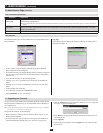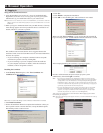
20
7.6.6 Customization
7. Administation
(
continued
)
7.6 Administration Page
(
continued
)
Login Failures
Allowed:• sets the number of consecutive failed login attempts that are
permitted from a remote computer.
Timeout:• sets the amount of time a remote computer must wait before
attempting to login again after it has exceeded the number of allowed
failures.
Working Mode
If • Stealth Mode is enabled,theNetDirectorConsoleKVMSwitchwith
IP Access cannot be pinged.
TopermitbrowseraccesstotheKVMswitch,clickthe• Enable Browser
checkbox. If browser access is not enabled, users will not be able to log
into the unit via their browsers.
Note: Before you disable browser access, you will need to download the
API versions of the Windows and Java Clients from the IP Home
Page. (See section 8.2 for details) The only way to access the API
versions is to access the KVM switch via a browser.
If • Multiuser Operationisenabled,upto32userscansimultaneously
accesstheKVMswitch.
If • Set default to grayscale is enabled, the remote display is changed to
grayscale. This can speed up I/O transfer in low bandwidth situations.
I/O
Clicking the • Attributes button brings up a dialog box that allows you to
set Share mode and Timeout threshold for each of the ports:
Set the port’s Share mode according to the information in the following
table:
To set a port’s Share mode, double click it to bring up the I/O attributes •
dialog box:
Miscellaneous
The functions performed by the remaining elements at the bottom of the
screen are described in the table on the next page:
The Customization dialog box is arranged in four major sections: Login
Failures;WorkingMode;I/O;anduntitledmiscellaneousfunctionsatthe
bottom. The functions of each of the Customization items are described in
the sections that follow.
Attribute Action
Exclusive
The first user to occupy the port has exclusive control over it.
No other user can view or access it.
Occupy
The first user to occupy the port has control over it. Up to 31
additional users can view its video output. The Timeout func-
tion applies to ports that have this setting selected.
Share
Allows up to 32 users to simultaneously share control over
the port. User input is placed in a queue and executed
sequentially. In addition, a user can access the KVM switch’s
Message Board function to gain control of the Share desig-
nated port. (See section 9.2.3, Message Board.)
The • Timeout field sets a time threshold for users on ports whose Share
Mode has been set to Occupy. If there is no activity from the user
occupying the port for the amount of time set here, the user is timed out
and the port is released. The first user to send keyboard or mouse input
after the port has been released gets to occupy the port. Input a value
from 0 to 255 seconds. The default is 3 seconds. A setting of 0 causes
the port to be released the instant there is no input.


















